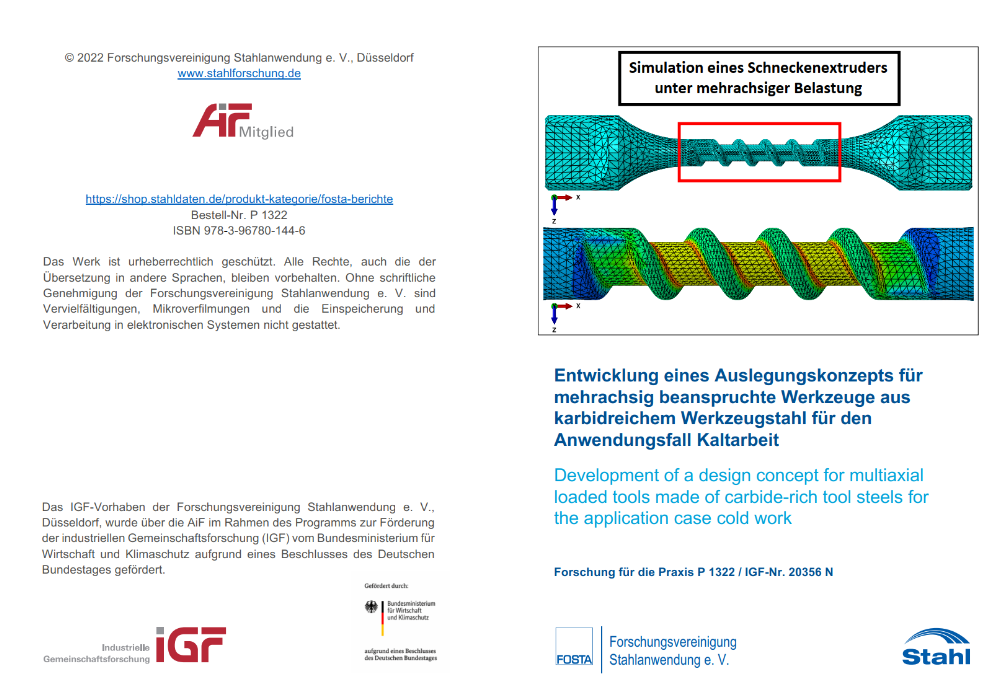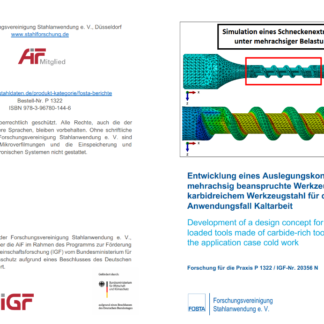Description
P 1322 – Development of a design concept for multiaxial loaded tools made of carbide-rich tool steels for the application case cold work
For cold work applications, carbide-rich, high-alloy tool steels are very often used as cutting, punching, cold forming or pressing tools. To increase the efficiency and productivity of forming processes, the service lives of cold work tools must be successively increased. The specific development of carbide-rich, highly wear-resistant alloys has steadily increased the service life of cold work tools over the past decades, so that often several million load cycles (or more) can be achieved in real operation of a tool. The wide range of requirements for tool steels has therefore been extended by an additional, decisive factor: the cyclic strength or fatigue strength of tool steels containing high amounts of carbides.
In particular, toolmaking and tool users in Germany are strongly organized in small and medium-sized enterprises (SMEs) and would benefit from increased tool life, a fundamental, statistical understanding of the factors influencing fatigue strength, and improved, targeted design and dimensioning of cold work tools. On the one hand, this can further increase the attractiveness and high quality of their products, and on the other hand, it creates new, innovative potential for SMEs in the new and further development of specific cold working tools. For the manufacturers of tool steels in Germany, new potentials and dynamic opportunities also arise in the field of targeted alloy development of tool steels with improved cyclic strength and wear properties. Overall, a significant contribution can be made here to maintaining and increasing the competitiveness of German SMEs on the European and international markets.
The German SMEs in the industrial plant and tool construction sector bundle a large part of the experience and knowledge for the design and construction of tools and tool steels, whereby these are mostly not oriented to standardized norms or design works, e.g. the FKM guidelines [1, 2, 3] or the DIN EN ISO 4957 [4], as is otherwise typical in mechanical engineering, but are mostly based on empirical values and practical test series built up over many years. In addition, there are no design-relevant values or cyclic (and static) material parameters available for tool steels in standards or guidelines.
Tool steel is the most frequently used material group in the construction of cold work tools and is subject to a very versatile requirement profile. The dominant requirements are high hardness, wear resistance and strength (set by the heat treatment and the hard phase content and type), sufficiently good toughness and, under certain circumstances for specific applications, also good hot hardness, tempering and corrosion resistance. In practice, experience shows that a compromise always must be made in order to achieve the appropriate balance between these different, sometimes conflicting requirements for each individual application. For toolmakers and designers, the chemical alloy composition, the manufacturing route (ingot casting, continuous casting, powder metallurgy), design adjustments to the geometry and the subsequent heat treatment offer a wide range of options for setting specific microstructures and tool properties, which are decisive in determining tool life. Due to the continuous further developments in the field of tool steels, wear or corrosion are now often no longer lifedetermining factors, and in the case of desired service life increases, the focus for SMEs and steel manufacturers lies increasingly on the previously rather insignificant criterion of fatigue strength, whereby tools are often exposed to non-proportional multi-axial fatigue loads (variableix principal stress directions) due to their operation. Currently, there is a lack of fundamental understanding of which factors, e.g. multiaxiality, microstructure and loading type, specifically influence the fatigue strength of tool steels. There is a lack of experimental investigations and statistical validation of fatigue strength values.
For German tool manufacturers and designers, a proper tool design according to fatigue criteria would result in a more efficient material utilization and an optimized service life estimation and prediction as well as allow a targeted material development according to fatigue criteria. In the future, a statistically validated, comprehensive database of fatigue strength values for carbiderich tool steels could be transferred into corresponding standards, calculation and design works and used for scientific tool design.
This research project therefore focuses on two fundamental questions:
1. What is the general quantitative effect of stress and microstructure variations on the fatigue strength of tool steels containing high amounts of carbides?
2. Based on which material parameters and using which failure hypotheses cold working tools should be designed regarding non-proportional multiaxial fatigue loading?
A cold work and a high-speed steel are tested in the underlying test matrix under uniaxial fatigue loading and systematic microstructure and loading variation. For fracture mechanical understanding of fatigue, threshold, long-crack propagation in the Paris regime and fracture toughness of these materials are analyzed as well. The obtained cyclic material properties serve as a basis for the development of a simulative design approach for non-proportional multi-axial, synchronously loaded tools with the quadratic failure hypothesis (QVH). In the case of nonproportional multiaxial loading (e.g. different forms of fatigue loading or different static mean stresses, frequency or phase shifts), in contrast to proportional multiaxial loading, both magnitude-varying principal stresses and changing principal stress directions would have to be explicitly taken into account by means of an extended failure hypothesis, e.g. QVH [5–8, 9–12] or SIH [13–20]. To validate the new design approach, the results of the QVH are compared with those of the shear stress intensity hypothesis (SIH), the FKM guideline [1, 3], and the two- and three-axis normal stress hypothesis (NH), shear stress hypothesis (SH), and shape change energy hypothesis (GEH) according to von Mises.
In parallel, an experimental validation under non-proportional multi-axial synchronous fatigue loading is performed on a 2-axis test machine (axial loading combined with superimposed torsional loading). As experimental reference tests, one cylindrical laboratory geometry and one tool-like, complex-notched geometry per material are investigated in statistical Wöhler tests.
The validation results can be used in the future to further develop the design approach and increase the accuracy of the predictions. The results of the research project show that the primary influencing factor on the fatigue strength of carbide-rich tool steels is the defect size (size of defects in the fracture mechanical sense). The size of microstructural, crack-inducing defects such as carbides or inclusions must be focused on as a significant factor in increasing the fatigue strengths of tool steels. The properties of the microstructure are mainly set during materialx production (and heat treatment). In cast microstructures, carbide size is the dominant factor, and in powder metallurgically produced materials, the size of non-metallic inclusions is the dominant factor. Powder metallurgically produced tool steels show significantly higher fatigue strengths due to the much smaller round carbides, which are very homogeneously distributed, with the location of crack initiation now changing to the larger non-metallic inclusions. The hot forming degree and the degree of cleanliness are therefore significant for the fatigue strength, as they directly influence the size and distribution of the carbides and inclusions. The secondary influencing factor is probably the matrix hardness, and the tertiary is the defect morphology. These three factors influence each other and there is a complex interaction between them which should be investigated more detailed in future.
Boundary layer nitriding with a pure diffusion layer can noticeably improve the fatigue strengths of carbide-rich tool steels, but depending on the defect size and the original matrix hardness. In particular, the fatigue strengths of PM tool steels (with comparatively very small non-metallic inclusions as crack-inducing defects) and their scatter of test values can be effectively improved via the high residual compressive stresses introduced during diffusion layer nitriding.
The results of the fracture mechanics tests illustrate that the threshold value for long crack growth and the fracture toughness in ingot cast tool steels are greater than in chemically identical, powder-metallurgically produced variants, irrespective of the stress ratio R. At the same time, the slope m of the Paris law for stable long crack growth is smaller in cast variants. This means that only the crack formation phase and possibly microcrack growth play a role for fatigue in tool steels. The significantly higher fatigue strengths of PM materials can be attributed exclusively to a drastically reduced and delayed crack initiation phase.
The experimental results of the multiaxial validation tests show strong deviations to the simulation results of the QVH. By modifying the orientation-dependent (anisotropic) fatigue strength calculations of the QVH, it was possible to achieve a significant improvement in accuracy, at least for the cylindrical laboratory geometry, for both tool steels investigated. For this purpose, an extrapolation in the Haigh diagram up to the stress ratio R = – infinity was used.
In most cases, the prediction calculation according to FKM shows smaller or even the smallest errors compared to the experimental validation. However, for the tool-like geometries, larger prediction errors up to about 80% still occur for all considered failure hypotheses. A prediction of the multi-axial fatigue strengths of complex-notched, real tools continues to represent a major challenge for all the hypotheses considered, which is why an improvement in accuracy should be the focus of future projects.
Regarding the standardization relevance of this research project, it can be summarized that the determined material parameters (static, uniaxial cyclic, multiaxial cyclic) were both extensively statistically validated and conscientiously tested with suitable testing machines in accordance with applicable standards. It is therefore intended to incorporate this database of cyclic values into current guidelines and standards (FKM guideline, DIN EN ISO tool steels) in order to enable and facilitate the use of the data in the future, particularly for SMEs.
The objective of the research project was achieved.
At the same time, new research hypotheses and questions were developed from the basic principles and findings obtained here, which were realized within the framework of a newxi proposal for a follow-up project. The follow-up project FOSTA P 1608 or IGF project no. 22271 N was approved and started on 01.03.2022.
All research reports in german language only!
Published in:
August 2022
Autoren:
Univ.-Prof. Dr.-Ing. Ch. Broeckmann, M.Sc. L. Scholl


